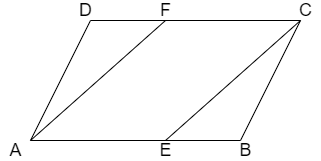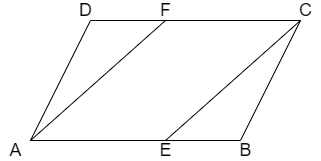
In the figure below ABCD is a parallelogram. AF and EC are the bisectors of \[\angle DAB\] and \[\angle BAC\] respectively, then \[AF\parallel CE\]

(a) True
(b) False

Answer
557.7k+ views
Hint: We solve this problem by using the bisector of an angle and the parallel lines theorems. The angular bisector is a line segment that divides the angle into two equal parts. We use some the conditions of parallelogram and parallel lines to solve this problem.
(1) For a parallelogram the opposite angles are equal.
(2) For a set of two parallel lines the transversal divides the parallel lines at equal corresponding angle and vice versa. That is for the following parallel lines we have

Here, if \[P\parallel Q,R\parallel S\] then the angle 1 and angle 2 both are equal and vice versa.
Complete step by step answer:
We are given that ABCD is a parallelogram.
We know that the opposite angles of a parallelogram are equal to each other.
By using the above condition to given parallelogram we get
\[\Rightarrow \angle DCB=\angle DAB........equation(i)\]
We are given that the lines AF and EC are the bisectors of \[\angle DAB\] and \[\angle BAC\] respectively
We know that the bisector of an angle divides the angle into two equal parts.
By using the above condition to both the angles \[\angle DAB\] and \[\angle BAC\] we get
\[\Rightarrow \angle DAF=\angle FAE\]
\[\Rightarrow \angle DCE=\angle ECB\]
Now, let us take the equation (i) and divide the two angles as the sum of other two angles that are divided then we get
\[\Rightarrow \angle DCE+\angle ECB=\angle DAF+\angle FAE\]
Now by substituting the above equal angles then we get
\[\begin{align}
& \Rightarrow 2\angle DCE=2\angle FAE \\
& \Rightarrow \angle DCE=\angle FAE \\
\end{align}\]
We know that for a set of two parallel lines the transversal divides the parallel lines at equal corresponding angle and vice versa. That is for the following parallel lines we have

Here, if \[P\parallel Q,R\parallel S\] then the angle 1 and angle 2 both are equal and vice versa.
Here, we know that vice versa means if one happens then another will happen.
Here we can see that \[\angle DCE=\angle FAE\] from the figure.
So, from the above condition we can say that \[FC\parallel AE\] and \[AF\parallel CE\]
Therefore, we can conclude that the quadrilateral AECF is a parallelogram and \[AF\parallel CE\]
So, the correct answer is “Option a”.
Note: We can have the other explanation of the above problem.
We have the given figure as

We have a standard result of a parallelogram that is the angular bisectors of the opposite angles of a parallelogram are always parallel.
Here we are given that AF and EC are the bisectors of \[\angle DAB\] and \[\angle BAC\]
Here, we can see that \[\angle DAB\] and \[\angle BAC\] are opposite angles of the parallelogram ABCD.
So, by using the standard result that is mentioned above we can say that \[AF\parallel CE\]
Therefore option (a) is the correct answer.
(1) For a parallelogram the opposite angles are equal.
(2) For a set of two parallel lines the transversal divides the parallel lines at equal corresponding angle and vice versa. That is for the following parallel lines we have

Here, if \[P\parallel Q,R\parallel S\] then the angle 1 and angle 2 both are equal and vice versa.
Complete step by step answer:
We are given that ABCD is a parallelogram.
We know that the opposite angles of a parallelogram are equal to each other.
By using the above condition to given parallelogram we get
\[\Rightarrow \angle DCB=\angle DAB........equation(i)\]
We are given that the lines AF and EC are the bisectors of \[\angle DAB\] and \[\angle BAC\] respectively
We know that the bisector of an angle divides the angle into two equal parts.
By using the above condition to both the angles \[\angle DAB\] and \[\angle BAC\] we get
\[\Rightarrow \angle DAF=\angle FAE\]
\[\Rightarrow \angle DCE=\angle ECB\]
Now, let us take the equation (i) and divide the two angles as the sum of other two angles that are divided then we get
\[\Rightarrow \angle DCE+\angle ECB=\angle DAF+\angle FAE\]
Now by substituting the above equal angles then we get
\[\begin{align}
& \Rightarrow 2\angle DCE=2\angle FAE \\
& \Rightarrow \angle DCE=\angle FAE \\
\end{align}\]
We know that for a set of two parallel lines the transversal divides the parallel lines at equal corresponding angle and vice versa. That is for the following parallel lines we have

Here, if \[P\parallel Q,R\parallel S\] then the angle 1 and angle 2 both are equal and vice versa.
Here, we know that vice versa means if one happens then another will happen.
Here we can see that \[\angle DCE=\angle FAE\] from the figure.
So, from the above condition we can say that \[FC\parallel AE\] and \[AF\parallel CE\]
Therefore, we can conclude that the quadrilateral AECF is a parallelogram and \[AF\parallel CE\]
So, the correct answer is “Option a”.
Note: We can have the other explanation of the above problem.
We have the given figure as

We have a standard result of a parallelogram that is the angular bisectors of the opposite angles of a parallelogram are always parallel.
Here we are given that AF and EC are the bisectors of \[\angle DAB\] and \[\angle BAC\]
Here, we can see that \[\angle DAB\] and \[\angle BAC\] are opposite angles of the parallelogram ABCD.
So, by using the standard result that is mentioned above we can say that \[AF\parallel CE\]
Therefore option (a) is the correct answer.
Recently Updated Pages
Two men on either side of the cliff 90m height observe class 10 maths CBSE

What happens to glucose which enters nephron along class 10 biology CBSE

Cutting of the Chinese melon means A The business and class 10 social science CBSE

Write a dialogue with at least ten utterances between class 10 english CBSE

Show an aquatic food chain using the following organisms class 10 biology CBSE

A circle is inscribed in an equilateral triangle and class 10 maths CBSE

Trending doubts
Why is there a time difference of about 5 hours between class 10 social science CBSE

Write a letter to the principal requesting him to grant class 10 english CBSE

What is the median of the first 10 natural numbers class 10 maths CBSE

The Equation xxx + 2 is Satisfied when x is Equal to Class 10 Maths

Which of the following does not have a fundamental class 10 physics CBSE

State and prove converse of BPT Basic Proportionality class 10 maths CBSE




